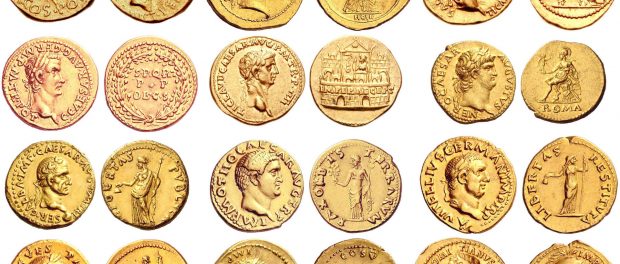History of Gold Coins As Money

Gold has a long and distinguished history as the metal of choice for money and coins. Even before it was struck into coins, people measured, used, and traded it to pay for trade goods and services and as a way to store their wealth. This legacy of gold began back around 2,700 years ago. Investors have craved gold for the safety and protection it provides for thousands of years on through today.
Earliest Use of Gold Coins
The first gold coins were struck and used as money in Lydia about 70 B.C. in what is now modern day Western Turkey. Silver already had a place next to gold at this time as these electrum coins contained 63% gold and 27% silver. These earliest simple coins helped Lydia to build up an enormous gold reserve. The phrase “rich as Croesus” the last king of Lydia is still used to describe the super-rich today.
In the following centuries, the use of gold in coins spread throughout the known world from the Mediterranean Sea to the near East. The Ancient Greeks sought gold far and wide, but they mostly used it for gold reserves rather than coins. Plato and Aristotle wrote concerning gold and what they believed were its origins by 550 B.C.. They saw gold as an dense mixture of sunlight and water. The Persian Empire over the next two centuries controlled enormous amounts of all the gold in the world and utilized it to strike huge numbers of their coins the gold darics. The trading Phoenicians and Carthage, a rich and powerful city-empire based in North Africa, mined gold in modern-day Spain and spread their coins far and wide. By the death of Alexander the Great, the Greeks had successfully mined gold as both state-owned and privately-run operations in the form of placer mines from Gibraltar to Egypt and Turkey.
The Roman Empire and Gold
The Romans amassed massive quantities of gold with their expansion and conquest of the Mediterranean and Near East. For much of their history, the Romans kept their gold more in reserve holdings than gold coins. This began to change when the Romans gave their generals the privilege to mint gold coins with which to pay their armies. General L. Cornelius Sulla struck the first such Roman gold aureus coins in significant quantities to immortalize his victory. Julius Caesar began the tradition of minting gold coins to use as a widespread coinage around the Roman Empire after he became de facto Emperor. Under Emperor Nero, the Roman gold coins were nearly pure and minted in significant amounts. He added a half aureus called a gold quinarius to the lineup of gold coins. At the peak of the Roman Empire, such Roman gold coins has spread from Egypt and North Africa, throughout the Roman European world, and even to distant province Britain.
Fraud with gold coins goes back to these Roman days. Modern day debasement of gold coins owes its first large scale precedent to the Roman Empire. Over the next 200 to 300 years, they reduced the amount of gold in the coins on several occasions. Because their coins were so widespread, people and foreign merchants continued to accept them for payment and in trade. When the Western Roman empire collapsed and Western Europe fell into a Medieval dark ages, the Byzantine (Eastern Roman) Empire continued the tradition of minting gold coins known as Bezants that achieved widespread use in gold coin hungry Medieval Europe. They eventually debased these coins as the Byzantine economy and empire declined.
The Rise of Modern Gold Coin Production
Italian city states began the tradition of modern gold coin techniques in production. Florence issued the golden florin while Venice had its gold ducats in the 1200s. The coins grew in fame and acceptance because of their purity. It was also the Renaissance Italians who made the first modern improvements to producing and designing coins. In past centuries, coins’ creators had always struck their coins by hand using a hammer and die with a blank planchet atop it. The Italians first created a machine which horses or water wheels powered so that the gold could be rolled into a consistent thickness for the planchets. Donato Bramante in Italy created his screw press that permitted the die to be precisely pressed into the planchet to strike the coin’s image evenly.
What we think of as modern day gold coins began in France and England. Henry II who reigned in France from 1547 to 1559 became the first modern monarch to include his own portrait on gold coinage. He brought in the new coin- making machines to Paris to make his coins. Improving design methods allowed for better pictures and portraits on coins. Starting in 1662, machines struck all English coinage.
Coins continued to be made from mostly gold (or otherwise silver) until paper money became widespread in the 1700s and 1800s. Even then, all paper money could be simply converted back into gold (or silver in the British Empire with Pound Sterling) at a fixed rate. It was only when the United States confiscated private gold in 1933 and then closed the gold window at last in the early 1970’s that money stopped being made out of or at least backed up by gold. This represented the latest efforts to debase the coinage that the Romans began around 1,700 years ago. History always repeats itself.

Will Your Retirement Weather the Next Financial Crisis?
Gold has been used as an inflation hedge and a way to preserve wealth for millennia. We partnered with Silver Gold Bull, Canada's top-rated gold company (with over 280,000 five-star reviews), to offer Canadians a low-cost and tax-advantaged way to buy gold and silver through an RRSP/TFSA or another retirement plan.
Request More Info
Website: www.SilverGoldBull.ca
Speak to an Expert: (877) 707-4707
Copyright 2023 Gold RRSP - Helping Canadians invest in physical bullion for retirement
